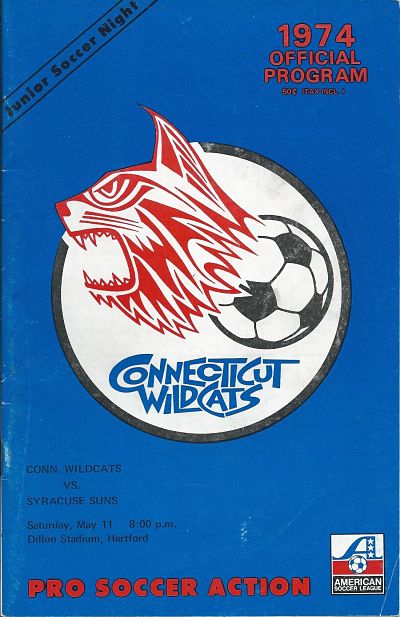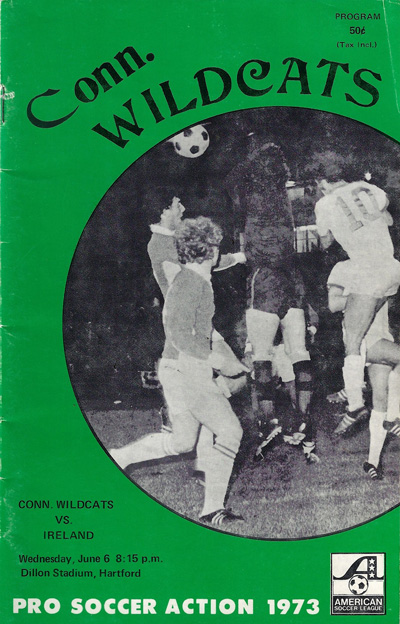American Soccer League (1973-1974)
Tombstone
Born: November 1972 – ASL expansion franchise
Folded: December 15, 19741Kohlinsky, Bohdan, “Wildcats Ousted; Re-Apply to ASL”, Courant (Hartford, CT), December 17, 1974
First Game: May 19, 1973 (W 4-1 vs. Syracuse Suns)
Last Game: September 7, 1974 ( T 3-3 @ Cleveland Stars)
ASL Championships: None
Stadium
Dillon Stadium
Opened: 1935
Marketing
Team Colors:
Ownership
Owner:
- 1973-1974: Paul Ingram
- 1974: Bob Kratzer
Background
The Connecticut Wildcats were the first of several pro soccer clubs to set up shop at Hartford’s Dillon Stadium during the mid-1970’s. The club formed in November 1972 as an expansion franchise in the 2nd Division American Soccer League.
Paul Ingram, a former All-American soccer player at UConn, founded the Wildcats and served as General Manager. Fielding a team of mostly American players, the Wildcats put up an 8-3-3 record in their debut season. The club was solid at the box office too. The ‘Cats drew 4,200 fans for their inaugural game in the spring of 1973. 10,000 more showed up for the season finale at Dillon Stadium against the Boston Astros. The ASL named Ingram its Executive-of-the-Year for the 1973 season.
Benny Brewster led the team in scoring in 1973 with 10 goals and 4 assists. The Wildcats best-known player, in retrospect, was the young goalkeeper Tony DiCicco. DiCicco went on to become one of the greatest coaches in the women’s game, leading the U.S. Women’s National Team to Olympic gold in 1996 and the World Cup in 1999.
Demise & Aftermath
As the Wildcats second season approached in the winter of 1974, Ingram asked for a renegotiation of the team’s rental agreement at Dillon Stadium. He stated the team’s rental rate and lack of revenue sharing on concessions were among the worst deals in the American Soccer League and that the team might need to relocate to Springfield, Massachusetts.
In the event, the Wildcats did end up returning to Dillon in 1974, but it proved to be the club’s final campaign. New owner Bob Kratzer stepped forward at mid-season to help the Wildcats finish out the season. In December 1974, league officials terminated the Wildcats franchise for financial insufficiency.2Kohlinsky, Bohdan, “Wildcats Ousted; Re-Apply to ASL”, Courant (Hartford, CT), December 17, 1974
But Kratzer immediately applied for an ASL expansion franchise to replace the Wildcats in Hartford and was approved. Kratzer’s Connecticut Yankees (1975-1978) began play in the spring of 1975. Hartford also got a 1st division expansion club in 1975 with the formation of the Hartford Bicentennials (1975-1976) of the North American Soccer League. The two clubs competed head-to-head for game dates and fans at Dillon Stadium in 1975.
Kratzer hauled the Yankees around Connecticut for the next several years, playing games in Hartford, East Haven and Stamford before going out of business after the 1978 season.
Connecticut Wildcats founder Paul Ingram was inducted into the Connecticut Soccer Hall of Fame in January 2004.
Connecticut Wildcats Shop
[auction-nudge tool=”listings”]
Downloads
6-6-1973 Connecticut Wildcats vs. Waterford (Ireland) Roster
6-6-1973 Connecticut Wildcats Roster
5-25-1974 Wildcats vs. New York Apollo Roster
Links
##


